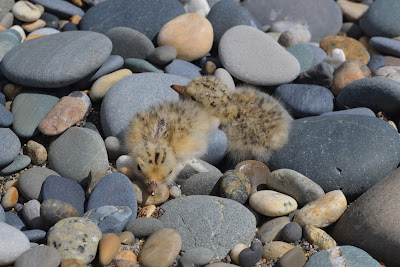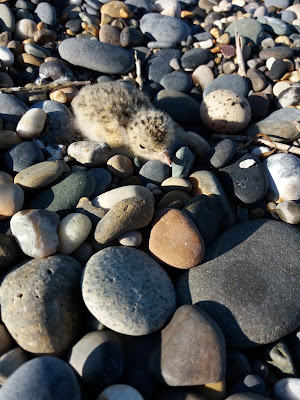Mayhem has descended on Kilcoole, as Little Tern chicks are hatching left, right and centre....
 |
| A pair of Little Tern chicks. Photo taken under NPWS licence. (I. Sullivan) |
The adult terns have become ever more protective and territorial, and have started utilising their arsenal of guano against the wardens. Nevertheless, the great work continues. Any chick found is being weighed, their wing lengths are measured, and they are ringed, so as to be able to identify them on future encounters as well as monitor their growth.
 |
| Chris, one of the two day wardens here at Kilcoole, weighing a Little Tern chick... like a pro. Picture taken under NPWS licence (I. Sullivan). |
It's a privilege to watch the Little Tern's journey from egg to chick on a daily basis, but the process is summarised quite nicely by the photo below, which shows a nest holding an egg, a newly hatched young 'un, and a chick a couple of days old.
 |
| From incubation to hatchling- the odyssey. Picture taken under NPWS licence (I. Sullivan). |
In terms of colony news, we found nest number 158 today, and we have 87 chicks!! The satellite colony is still going strong, with 20 nests found, and it's thought that 16 of these are active. The main colony currently supports at least two Oystercatcher nests and at least three Ringed Plover nests. Unfortunately, a local pair of Mute Swans with 7 cygnets appear to have lost one, but the other 6 are going strong. The biodiversity of Kilcoole is extraordinary, and as always we would love to hear of your sightings, so be sure to share them with the wardens as you pass by the colony. The blackboards which display colony news and species spotted in the locality are propped by the north end of the colony, and there's always room to add to the species list!
 |
| The Daily Page Terner- the latest colony scandal, gossip, and craic. (By I. Sullivan). |
Finally, we would like to introduce Pádraig Webb, our volunteer of the hour! Pádraig, who just finished his first year studying Wildlife Biology at I.T. Tralee, will be helping out at the colony over the next couple of days. He is very knowledgeable about birds, plants and other wildlife, and has already proven to be a great addition to the Kilcoole team.
 |
| Pádraig Webb on his first day volunteering for the Kilcoole Little Tern Project. (I.Sullivan). |
That's all for the moment! As always, a massive thanks to those of you following our progress, and to the wonderful locals of Kilcoole for their interest in the project and the care they show when using the beach. Until next time!
- Irene and The Kilcoole Team


















